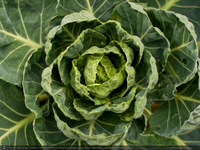Posted by Horton Tatarian, research biochemist, on 18th Aug 2015
Consume Non-Toxic Calcium

Commercial advertising and official dietary guidelines promote milk and other dairy products as the best sources of calcium for bone health. Unfortunately, government agencies and most nutritionists are slow to accept the latest scientific findings on this issue.
You may recall advertisements by the National Dairy Council, which claimed "Milk Is Good for Every Body" or "Milk Does a Body Good." Many scientific findings state otherwise. Nevertheless, various experts and agencies continue to promote dairy products as excellent calcium sources.
The mammary glands of cows secrete large amounts of calcium. The bones of cows are also large and strong, but cows don't drink milk to obtain their calcium.
Cow's milk is nature's formula only for calves under about nine months of age. Our infants become seriously ill after drinking cows milk. Why, then, are adult humans drinking milk from a cow? Physiologically, nutritionally, and logically this behavior makes no sense whatsoever. Scientific evidence indicates that we would do better to obtain our calcium from vegetation, as does the cow.
The following two studies do not show protection from bone fracture by consuming dairy products. In fact, they suggest an increase in bone fracture risk. The first study is dated 1994. The second one, dated 2014, also revealed a higher death rate from dairy product consumption.
Bone Fracture
Smoking, underweight in old age, overweight at age 20 years, and weight loss were associated with an increased risk of hip fracture. Consumption of dairy products, particularly at age 20 years, was associated with an increased risk of hip fracture in old age. . . . Some of the results of this study were unanticipated and may be due to chance or bias. If confirmed by other studies, these results would challenge some current approaches to hip fracture prevention. PMID: 8154473
High milk intake was associated with higher mortality in one cohort of women and in another cohort of men, and with higher fracture incidence in women. Given the observational study designs with the inherent possibility of residual confounding and reverse causation phenomena, a cautious interpretation of the results is recommended. PMID: 25352269
Animal products such as meat, milk, and other dairy products, are acidic (lacking electrons). Acidic foods and drinks tend to draw calcium from the bones and promote oxidative stress. Thus, daily calcium requirements are much lower when you consume a plant-based (alkaline, electron-supplying) diet high in fruits and vegetables.
Alkaline foods (fruits and vegetables) support bone health and reduce oxidative stress. Acidic foods (animal products, grains, and baked goods) do the opposite. Damage from excessive oxidative stress is the primary underlying cause of the current epidemics of chronic disease. See How Stress Causes Disease, Part 2.
Research findings also associate cow’s milk and cheese to infection, toxic chemical exposure, and cancer. Here are a few of these findings:
Infection
To deal with the threat of a bioterror attack involving a botulinum toxin release into the milk supply, some dairy processors increased the times and temperatures of pasteurization well above the legal minimum for high temperature. . . . Annual listeriosis deaths from consumption of this milk would increase from 18 to 670, a 38-fold increase. PMID: 24780323
Pasteurization temperatures and duration does not kill Mycobacterium avium subsp paratuberculosis (MAP), which appears associated with some cases of Crohn’s disease. PMID: 21620785
The likelihood of dairy and meat products being contaminated with MAP (Mycobacterium avium subsp paratuberculosis) on retail sale should not be ignored. PMID: 19486426
Toxic Chemical Exposure
Applying the World Health Organization's (WHO) 2005 [toxic equivalency factor] values and estimating average U.S. daily dietary intakes of 25 [dioxin-like compounds] from eight food categories, we estimate a toxic equivalency intake of 23 pg/day. Among food categories, milk (14%), other dairy (28%), beef (25%), and seafood (18%) most influenced [toxic equivalency] intakes. PMID: 23973911
Cancer
Consumption of cow's milk and cow's milk protein result in changes of the hormonal axis of insulin, growth hormone and insulin-like growth factor-1(IGF-1) in humans. . . . The milk-induced change of the IGF-1-axis most likely contributes to . . . atherosclerosis, carcinogenesis and neurodegenerative diseases. Observations of molecular biology are supported by epidemiologic data and unmask milk consumption as a promoter of chronic diseases of Western societies. PMID: 19243483
Increased consumption of animal-derived food may have adverse effects on the development of hormone-dependent cancers. Among dietary risk factors, we are most concerned with milk and dairy products, because the milk we drink today is produced from pregnant cows, in which estrogen and progesterone levels are markedly elevated. PMID: 16125328
Species-specific risk factors for [colon and breast] cancers are compatible with the transmission of different infectious factors transferred via meat or dairy products. PMID: 25648405
People with lactose intolerance, characterised by low consumption of milk and other dairy products, had decreased risks of lung, breast, and ovarian cancers, but the decreased risks were not found in their family members, suggesting that the protective effects against these cancers may be related to their specific dietary pattern. PMID: 25314053
Therefore, when someone asks you "Got milk?" you might explain why you don't.
A plant-based diet high in fruits and vegetables supports health and longevity. Even U.S government guidelines promote more than twice the amount of fruits and vegetables than U.S. citizens consume. See the 2-minute video, State Indicator Report on Fruits and Vegetables at NutritionFacts.org. Also see 25 Vegan Sources for Calcium at Care2.com.
However, be aware of the quality and safety the fruits and vegetables that you eat. Your fruits, vegetables, and other foods should be free of herbicides, pesticides, and genetically modified organisms (GMOs). See our slideshow, Eat Foods High In Electrons.
When possible, buy local, organic foods and grow some yourself. Everyone can sprout seeds. See How to Soak & Sprout Nuts, Seeds, Grains, & Beans at VegetarianTimes.com.
About Horton Tatarian

I’m a biochemist who examines scientific findings on health and disease. My degree in biochemistry is from U.C. Berkeley. UCLA School of Medicine granted an M.D. degree in 1974. Since then, independent research prepared me to advise clients on natural ways of self-care.

